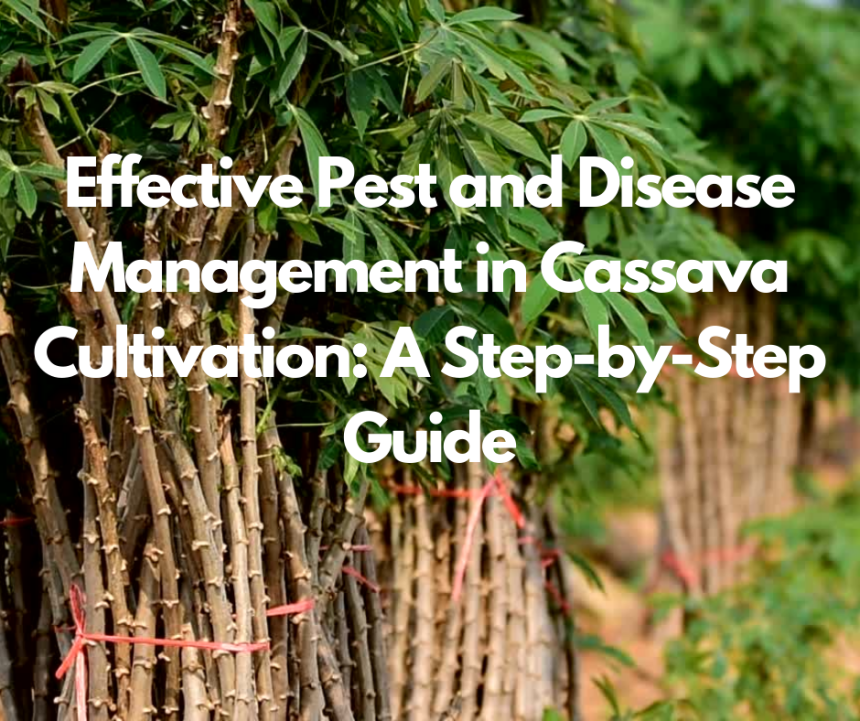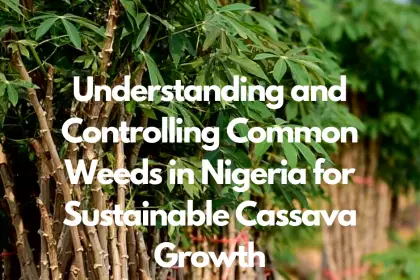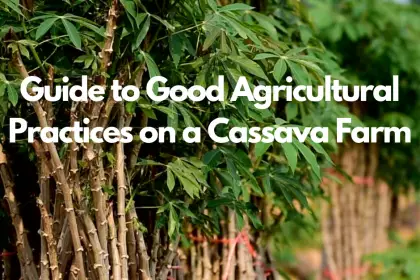Cassava is a cornerstone of food security for smallholder farmers in tropical regions, offering resilience in the face of challenging climatic, soil, or societal conditions. As the fourth most crucial carbohydrate source in the tropics, after rice, sugar, and maize, cassava plays a pivotal role in the diets and economies of one-third of the world’s low-income, food-deficit countries. However, the prosperity of cassava cultivation is threatened by pests and diseases, which significantly impact yield and economic stability.
To safeguard cassava crops against these threats, this article outlines effective strategies for managing the disease of cassava and controlling pests. It delves into integrated pest management strategies, advancements in biological control methods, and the importance of adopting disease-resistant cassava varieties. The article aims to provide a comprehensive guide on mitigating the risks posed by pests and diseases in cassava cultivation, offering valuable insights for ensuring the crop’s productivity and longevity.
Understanding Cassava Pests and Diseases
In the cultivation of cassava, a staple food crop for millions globally, understanding the spectrum of pests and diseases is crucial for effective management and ensuring high yields. This section delves into the primary biotic challenges faced by cassava crops and outlines the symptoms, causes, and management strategies for the most prevalent diseases and pests.
Key Cassava Pests and Diseases:
- Cassava Mosaic Disease (CMD) and Cassava Brown Streak Disease (CBSD) significantly hinder cassava production, especially in Sub-Saharan Africa. CMD, caused by cassava mosaic begomoviruses and transmitted by whiteflies, can lead to yield losses between 20%-90%. Symptoms include yellowing, distortion of leaves, stunted growth, and misshapen leaflets. CBSD, on the other hand, is caused by two species of ipomoviruses and leads to root necrosis, manifesting as dry hard rot in roots and stems, severely affecting the quality and quantity of cassava produced.
- Invasive Pests: The Cassava Mealybug (CM) and Cassava Green Mite (CGM) are invasive pests, with 70% and 54% of fields in Southeast Asia infested, respectively. The cassava mealybug feeds on the plants, injecting a toxin that causes leaf withering and stunted growth, potentially resulting in over 60% crop yield losses. The green mite affects leaves and shoot tips, reducing tuber yields by 14-80%.
- Other Notable Pests and Diseases: The Variegated Grasshopper causes defoliation of cassava stems, leading to yield loss, particularly severe in the dry season. Cassava Witches Broom (CWB), a systemic phytoplasma disease, has been reported in 64% of plots in Southeast Asia.Management Strategies:
- Host-Plant Resistance and Genetic Improvement: Efforts have focused on developing resistance against major diseases like African cassava mosaic disease, cassava bacterial blight, and anthracnose. Engineering disease-resistant cassava varieties, particularly against CMD, CBSD, and cassava bacterial blight (CBB), has shown promise. Techniques such as RNA interference (RNAi) and the potential use of CRISPR/Cas technology for editing susceptibility genes are at the forefront of genetic improvement strategies.
- Biological Control: The management of the cassava mealybug and the cassava green mite using parasitoids and natural enemies introduced from Latin America has been successful. This approach underscores the importance of biological control methods in managing biotic stresses on cassava.
- Integrated Pest Management (IPM): Regular inspection of cassava gardens for signs of pests, planting resistant or tolerant varieties, practicing crop rotation, and utilizing disease-free planting material are critical components of an integrated pest management strategy. These practices help in controlling both cassava pests and diseases effectively.Understanding the disease of cassava and its pests, coupled with adopting integrated management strategies, is essential for safeguarding cassava crops. By focusing on host-plant resistance, genetic improvement, biological control, and IPM strategies, farmers can mitigate the impact of these biotic stresses, ensuring the crop’s productivity and longevity.
Integrated Pest Management (IPM) Strategies
Integrated Pest Management (IPM) Strategies in cassava cultivation encompass a holistic approach, combining biological, cultural, and genetic tactics to minimize pest and disease impact. This section outlines the core components of IPM for cassava, emphasizing the synergy between different control methods for effective management.
- Monitoring and Research:
-
- Intensified monitoring and evaluation of cassava fields to identify pest and disease presence early.
- Ongoing research to understand pest behaviors and disease spread, aiding in the development of targeted control strategies.
- Cultural and Biological Controls:
-
- Preventive Measures:
-
- Plant early at the onset of rains to reduce the risk of Cassava Green Mite infestation.
- Implement crop rotation to prevent pest build-up and disrupt the life cycle of Cassava Mealy Bugs and Green Mites.
- Maintain field hygiene by clearing and burning crop residues post-harvest to reduce pest and disease survival.
- Biological Controls:
-
- Utilize natural enemies such as predatory mites, parasites, and the parasitic wasp for Cassava Mealy Bugs, emphasizing the role of biological control in IPM.
- Encourage ecosystem-based practices like mulching and intercropping to provide habitats for natural predators.
- Genetic and Chemical Management:
-
- Resistant Varieties:
-
- Adopt cassava varieties resistant or tolerant to major pests and diseases like Cassava Mosaic Disease (e.g., NASE 14, 15, 16, 17, 18, 19, NAROCAS 1, 2, and TME 14, 204) and Cassava Brown Streak Disease (e.g., NASE 14, 19, and NAROCAS1).
- Use disease-free planting material to prevent the introduction and spread of diseases.
- Selective Pesticide Use:
-
- Minimize the use of synthetic insecticides, fungicides, and herbicides to maintain the natural crop ecosystem balance.
- Apply low-risk selective pesticides in the right quantity and at the right time for targeted control, ensuring not to disrupt biological control agents.
- Biopesticides, such as neem seed oil extract, are recommended for controlling pests like whiteflies, mealybugs, and variegated grasshoppers.Implementing IPM strategies involves a coordinated effort to combine various control methods, ensuring a sustainable approach to managing pests and diseases in cassava cultivation. By integrating genetic improvement, cultural practices, biological control, and judicious chemical use, farmers can effectively manage pest and disease populations, safeguarding cassava productivity and longevity.
Advancements in Biological Control Methods
Sustainable Plant Health Management (PHM) has emerged as a forward-thinking approach in the battle against cassava pests and diseases. This strategy emphasizes the importance of viewing the cassava plant within the broader context of its agro-ecosystem. By doing so, it allows for a more holistic understanding of the interactions between the plant and its environment, including pests and diseases. This perspective is instrumental in devising more effective, sustainable management practices that are in harmony with the ecosystem, rather than against it.
- Host-Plant Resistance and Biological Control: At the core of managing biotic stresses in cassava are two pivotal strategies:
-
- Host-Plant Resistance: Developing cassava varieties that inherently resist pests and diseases through genetic improvement. This strategy not only reduces the reliance on chemical controls but also contributes to the long-term sustainability of cassava cultivation.
- Biological Control: Utilizing natural predators and control agents to manage cassava pests. This method aligns with the principles of PHM by promoting balance within the agro-ecosystem and minimizing negative impacts on the environment.Advancements in modeling have significantly enhanced the surveillance, detection, and control of cassava pests. These models provide valuable insights into the dynamics between cassava and its pests, facilitating the development of targeted management strategies. Additionally, they offer a deeper understanding of how molecular mechanisms of plant defense operate, paving the way for innovative approaches to bolster cassava’s resilience against pests and diseases. Furthermore, these models are instrumental in assessing the potential impacts and uncertainties posed by climate change on cassava pests, enabling researchers and farmers to anticipate and prepare for future challenges.
- Recent Advances in Understanding Molecular Mechanisms of Plant Defence:
-
- Improved Modeling: Tools and techniques for better predicting and managing pest outbreaks.
- Climate Change Insights: Analysis of how shifting climate patterns affect pest dynamics and cassava vulnerability.
- Molecular Mechanisms: Exploration of cassava’s innate defense systems at the molecular level, offering new avenues for enhancing pest and disease resistance through genetic and biological methods.By integrating these advanced methodologies and insights, the management of cassava pests and diseases can be significantly improved, ensuring the crop’s productivity and sustainability for years to come.
Importance of Disease-Resistant Varieties
Breeding for disease resistance in cassava presents a multifaceted approach to combating the challenges posed by pests and diseases, particularly Cassava Brown Streak Disease (CBSD) and Cassava Mosaic Disease (CMD). Despite the difficulty in achieving full resistance to CBSD, with only partial resistance observed in current cultivars, the development of disease-resistant varieties remains a cornerstone in the sustainable management of cassava diseases. These efforts are complemented by traditional methods such as the removal of symptomatic plants and the use of virus-free planting materials, although these practices are labor-intensive and not wholly effective.
- Strategies for Developing Disease-Resistant Varieties:
-
- Genetic Improvement: Utilizing conventional crossing techniques to transfer immune traits from wild types into improved cassava varieties. This method has successfully produced cultivars that withstand diseases such as CMD and CBSD.
- Molecular Techniques: Employing advanced techniques like RNA silencing to develop resistance against common viruses. These methods offer advantages over traditional breeding by directly targeting and modifying the genes responsible for disease susceptibility.
- Utilization of Genetic Markers: Identifying genetic markers for resistance to various viruses in African cassava varieties accelerates breeding efforts, enabling the rapid development of disease-resistant cultivars.The deployment of disease-resistant cassava varieties has shown significant impact in reducing infection rates, yield losses, and the rapid spread of diseases across growing areas. Over the past two decades, more than 200 improved cassava varieties resistant to mosaic disease have been released, highlighting the effectiveness of breeding programs in mitigating the impact of cassava diseases. Furthermore, several varieties resistant to brown streak disease have been developed, providing crucial support to farmers in regions heavily impacted by this virus.
- Impact and Adoption:
-
- Reduced Infection Rates: Disease-resistant varieties have been instrumental in bringing down infection rates and yield losses, particularly for CMD and CBSD.
- Prevention of Spread: By preventing the rapid spread of diseases across growing areas, these varieties play a vital role in safeguarding cassava cultivation in major growing areas.
- Farmer Preferences: Farmers often select vigorous and/or symptomless plants for new plantings, underscoring the importance of visibly healthy, disease-resistant varieties.In conclusion, the importance of disease-resistant varieties in cassava cultivation cannot be overstated. Through a combination of genetic improvement, molecular techniques, and the strategic use of genetic markers, significant strides have been made in developing cassava cultivars that can withstand the onslaught of pests and diseases. The continued focus on breeding resilient cultivars, spearheaded by research institutions like the International Institute of Tropical Agriculture (IITA), remains crucial in ensuring the sustainability and productivity of cassava cultivation in the face of ongoing and emerging biotic challenges.
Future Challenges and Opportunities in Cassava Pest and Disease Management
Global cassava production and its distribution highlight the significance of this crop across continents, with a notable concentration in Africa, Asia, and Latin America. The diverse utilization of cassava, spanning human consumption, animal feed, and industrial purposes, underscores its multifaceted role in global agriculture. However, the challenges posed by pests and diseases, exacerbated by climate change and intensified cropping systems, necessitate a forward-looking approach to cassava pest and disease management.
- Climate Change and Pest Dynamics:
-
- Climate change is projected to increase the prevalence of Cassava Mosaic Disease (CMD), Cassava Brown Streak Disease (CBSD), and the whitefly vector in key cassava-producing regions. This shift calls for an adaptive pest management strategy that incorporates climate resilience.
- Modelling studies have been pivotal in understanding the epidemiology of cassava diseases and arthropods. Future models need to integrate climate change effects more comprehensively to aid in developing robust management strategies.
- Sustainable Plant Health Management (PHM):
-
- Embracing PHM, which views the cassava plant as part of an agro-ecosystem, offers a holistic approach to managing diseases and pests. This strategy promotes the balance between cassava cultivation and its environment, aiming to minimize adverse impacts.
- Institutions like the International Institute of Tropical Agriculture (IITA) and the Centro International de Agricultura Tropical (CIAT) have been instrumental in cassava improvement efforts. Their continued focus on developing disease-resistant varieties and sustainable management practices is crucial for future success.
- Challenges in Resistance and Modelling:
-
- The evolution of resistance in plants and pathogens presents a significant challenge in disease modelling. Accurately reproducing these dynamics is essential for predicting and mitigating the impact of diseases on cassava.
- While resistant varieties offer a promising solution, their effectiveness is contingent upon careful deployment. There is a risk that resistance could be overcome by the evolution of virulent pathogen strains, highlighting the need for ongoing research and adaptation in breeding programs.The future of cassava pest and disease management lies in a multi-faceted approach that combines genetic improvement, sustainable agricultural practices, and a deeper understanding of the interplay between climate change, pest dynamics, and plant defense mechanisms. Through international collaboration and scientific innovation, it is possible to safeguard cassava cultivation against current and emerging threats, ensuring its continued contribution to global food security and agricultural sustainability.
Conclusion
Throughout the exploration of effective pest and disease management in cassava cultivation, it becomes evident that integrated strategies encompassing genetic improvement, biological control, and sustainable plant health management are pivotal. The diligent development and deployment of disease-resistant cassava varieties, alongside a commitment to ecological balance and advanced breeding techniques, showcase a forward-thinking approach to securing cassava production. This collective endeavor not only mitigates detrimental impacts on yields but also enhances the longevity and productivity of cassava as a critical food crop globally.
Looking forward, the challenges posed by climate change, evolving pest dynamics, and the perpetual need for sustainable agricultural practices underscore the importance of ongoing research and innovation. Strengthened by international collaboration and scientific advancements, the future of cassava pest and disease management holds promising opportunities for improvement. Ensuring the adaptability and resilience of cassava cultivation techniques will be instrumental in maintaining the crop’s significant role in global food security and agricultural sustainability.
FAQs
Q: What methods are used to manage pests and diseases in cassava cultivation?
A: To manage pests and diseases in cassava, it is important to enhance the plant’s natural resistance or tolerance by applying the right amounts of mineral fertilizer or manure. It is advised to avoid using insecticides on the leaves of cassava plants, as these can harm the beneficial organisms that naturally control some of the major pests and diseases.
Q: Can you describe the best practices for cultivating cassava?
A: The best practices for cultivating cassava include maintaining effective weed control, particularly during the early growth stages of the crop to ensure optimum yields. This is typically achieved through cultural practices such as selecting the right planting density, using vigorous cultivars, implementing intercropping strategies, minimizing tillage, using cover crops, and applying mulches.
Q: What type of pesticide is recommended for use on cassava plants?
A: For cassava plants, biopesticides like neem seed oil extract are recommended to control pests such as whiteflies, mealybugs, and variegated grasshoppers. Sticky traps and soapy water sprays can also be effective in reducing the populations of whiteflies and mealybugs.
Q: What are the steps involved in growing cassava?
A: The step-by-step process for growing cassava includes selecting a suitable site, preparing the soil, choosing the right cassava variety, arranging the necessary equipment, setting up irrigation systems, considering the climatic conditions, planting cassava stems, and implementing weed control measures.



